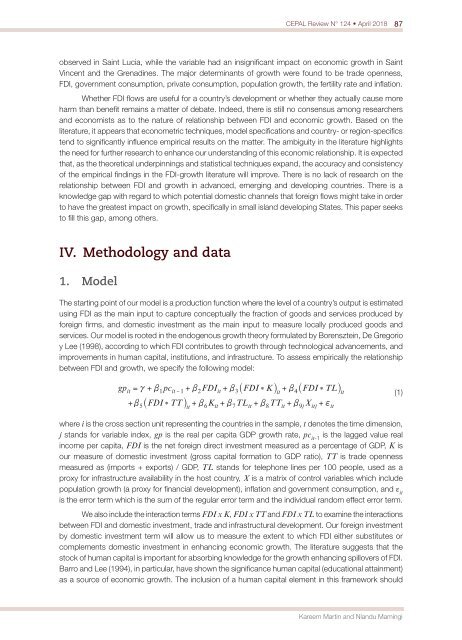CEPAL Review no. 124
April 2018
April 2018
You also want an ePaper? Increase the reach of your titles
YUMPU automatically turns print PDFs into web optimized ePapers that Google loves.
<strong>CEPAL</strong> <strong>Review</strong> N° <strong>124</strong> • April 2018<br />
87<br />
observed in Saint Lucia, while the variable had an insignificant impact on eco<strong>no</strong>mic growth in Saint<br />
Vincent and the Grenadines. The major determinants of growth were found to be trade openness,<br />
FDI, government consumption, private consumption, population growth, the fertility rate and inflation.<br />
Whether FDI flows are useful for a country’s development or whether they actually cause more<br />
harm than benefit remains a matter of debate. Indeed, there is still <strong>no</strong> consensus among researchers<br />
and eco<strong>no</strong>mists as to the nature of relationship between FDI and eco<strong>no</strong>mic growth. Based on the<br />
literature, it appears that eco<strong>no</strong>metric techniques, model specifications and country- or region-specifics<br />
tend to significantly influence empirical results on the matter. The ambiguity in the literature highlights<br />
the need for further research to enhance our understanding of this eco<strong>no</strong>mic relationship. It is expected<br />
that, as the theoretical underpinnings and statistical techniques expand, the accuracy and consistency<br />
of the empirical findings in the FDI-growth literature will improve. There is <strong>no</strong> lack of research on the<br />
relationship between FDI and growth in advanced, emerging and developing countries. There is a<br />
k<strong>no</strong>wledge gap with regard to which potential domestic channels that foreign flows might take in order<br />
to have the greatest impact on growth, specifically in small island developing States. This paper seeks<br />
to fill this gap, among others.<br />
IV. Methodology and data<br />
1. Model<br />
The starting point of our model is a production function where the level of a country’s output is estimated<br />
using FDI as the main input to capture conceptually the fraction of goods and services produced by<br />
foreign firms, and domestic investment as the main input to measure locally produced goods and<br />
services. Our model is rooted in the endoge<strong>no</strong>us growth theory formulated by Borensztein, De Gregorio<br />
y Lee (1998), according to which FDI contributes to growth through tech<strong>no</strong>logical advancements, and<br />
improvements in human capital, institutions, and infrastructure. To assess empirically the relationship<br />
between FDI and growth, we specify the following model:<br />
(1)<br />
where i is the cross section unit representing the countries in the sample, t de<strong>no</strong>tes the time dimension,<br />
j stands for variable index, gp is the real per capita GDP growth rate, pc it-1<br />
is the lagged value real<br />
income per capita, FDI is the net foreign direct investment measured as a percentage of GDP, K is<br />
our measure of domestic investment (gross capital formation to GDP ratio), TT is trade openness<br />
measured as (imports + exports) / GDP, TL stands for telephone lines per 100 people, used as a<br />
proxy for infrastructure availability in the host country, X is a matrix of control variables which include<br />
population growth (a proxy for financial development), inflation and government consumption, and ε it<br />
is the error term which is the sum of the regular error term and the individual random effect error term.<br />
We also include the interaction terms FDI x K, FDI x TT and FDI x TL to examine the interactions<br />
between FDI and domestic investment, trade and infrastructural development. Our foreign investment<br />
by domestic investment term will allow us to measure the extent to which FDI either substitutes or<br />
complements domestic investment in enhancing eco<strong>no</strong>mic growth. The literature suggests that the<br />
stock of human capital is important for absorbing k<strong>no</strong>wledge for the growth enhancing spillovers of FDI.<br />
Barro and Lee (1994), in particular, have shown the significance human capital (educational attainment)<br />
as a source of eco<strong>no</strong>mic growth. The inclusion of a human capital element in this framework should<br />
Kareem Martin and Nlandu Mamingi


















